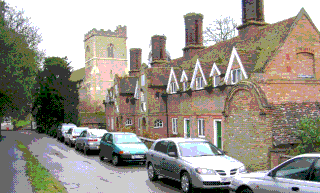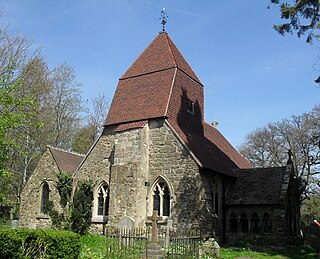
Naseby is a village in West Northamptonshire, England. The population of the civil parish at the 2011 Census was 687.

Quainton is a village and civil parish in Buckinghamshire, England, 7 miles (11 km) north-west of Aylesbury. The population of the civil parish at the 2011 Census was 1,295. The village has two churches, a school and one public house. The location means that while many commute to London, others are employed in neighbouring towns and villages.

Wingrave is a village in Buckinghamshire, England, about four miles north east of Aylesbury and three miles south west of Wing.

Ickleton is a village and civil parish about 9 miles (14 km) south of Cambridge in Cambridgeshire, England. The village is beside the River Cam, close to where a southern branch of the Icknield Way crossed the river. The eastern and southern boundaries of the parish form part of the county boundary with Essex, and the Essex town of Saffron Walden is only about 4.5 miles (7 km) southeast of the village.

Ham is a small village and civil parish in Wiltshire, England. The parish borders the county of Berkshire, and the village lies about 3+1⁄4 miles (5.2 km) south of the Berkshire town of Hungerford.

Broughton is a village and civil parish in the City of Preston, Lancashire, England, approximately 4 miles (6 km) north of Preston city centre. According to the 2001 census it had a population of 1,735, decreasing to 1,722 at the 2011 Census, increasing to 2,467 at the 2021. The parish is included in Preston Rural East ward of Preston city council, and the Preston Rural division of Lancashire County council.

St Luke's Church is in the village of Goostrey, Cheshire, England. It is recorded in the National Heritage List for England as a designated Grade II* listed building. It is an active Anglican parish church in the diocese of Chester, the archdeaconry of Macclesfield and the deanery of Congleton. Its benefice is combined with that of St Peter, Swettenham.

Bremhill is a village and civil parish in Wiltshire, England. The village is about 1.6 miles (2.6 km) northwest of Calne and 4 miles (6.4 km) east of Chippenham. The name originates from 'Bramble hill'.

Keevil is a village and civil parish in Wiltshire, England, about 4 miles (6 km) east of the centre of Trowbridge and a similar distance south of Melksham. The village lies on a slope between Great Hinton and Bulkington. Semington Brook forms much of the northeast boundary of the parish.

Norwell is a village and parish about 6 miles (9.7 km) from Newark-on-Trent, in central Nottinghamshire, England. The population at the 2011 census was 490. It is close to the border with Lincolnshire and the River Trent, and lies approximately 1.5 miles (2.4 km) from the A1 road and 1 mile (1.6 km) from the East Coast Main Line.

Warborough is a village and civil parish in South Oxfordshire, about 2.5 miles (4 km) north of Wallingford and about 9 miles (14 km) south of Oxford. The parish also includes the hamlet of Shillingford, south of Warborough beside the River Thames.

Matching is a village and civil parish in the Epping Forest district of Essex, England centred in countryside 3 miles (4.8 km) east of Harlow's modern town centre and 2 miles (3.2 km) from Old Harlow/Harlow Mills area of the town. The terrain is elevated and London is centred 21.7 miles (34.9 km) to the south-west.

East Worldham is a village and former civil parish, now in the parish of Worldham, in the East Hampshire district of Hampshire, England. It is 1.9 miles (3.1 km) east of Alton; and 1.9 miles (3.1 km) south-west of Wyck. Hartley Mauditt and West Worldham are nearby, which, along with East Worldham, form the parish of Worldham. The village is just east of the A31 road and contains St Mary's Church and the Three Horse Shoes pub, amongst other buildings. Worldham Golf Course located just to west and Dean Farm Golf Course just to the east. For centuries the village and surrounding parish were owned by Winchester College. In 1931 the parish had a population of 208.
Haselor is a village in Warwickshire. It is by the River Alne, about one mile east of Alcester just off the A46 main road to Stratford-upon-Avon. The parish church is remote from the present houses, the old village having been demolished after a plague epidemic.

St Mary the Virgin is a 13th-century Anglican parish church in Northolt, London Borough of Ealing. It is on a slope shared with Belvue Park, the site of a 15th-century manor house — both overlooked the old village of Northolt. It is one of London's smallest churches, its nave measuring 15 yards (14 m) by 8 yards (7.3 m). The church was built around 1290 and was expanded over the centuries, with the chancel being added in 1521, the spired bell tower in the 16th century, and a gallery at the west end of the church in 1703. Twin buttresses were erected against the west wall around 1718 to alleviate concerns that the church could slip down the hill. The internal beams are original and the bells date from the 17th century. The church was constructed from a variety of materials; the nave incorporates clunch, flint and ironstone, and the mouldings of the doors and windows are made from Reigate Stone.

Stanton St. John is a village and civil parish in Oxfordshire about 4.5 miles (7 km) northeast of the centre of Oxford. The village is 330 feet (100 m) above sea level on the eastern brow of a group of hills northeast of Oxford, in a slight saddle between two of the hills.

Little Tew is an English village and civil parish about 4+1⁄2 miles (7 km) northeast of Chipping Norton and 8+1⁄2 miles (14 km) southwest of Banbury in Oxfordshire. The parish is bounded to the northwest by the River Swere and a road between Little Tew and Hook Norton, to the north by a tributary of the River Cherwell and to the south by an ancient drovers' road called Green Lane. The remaining parts of the parish bounds are field boundaries. The 2011 Census recorded the parish's population as 253.

Church in the Wood, officially known as St Leonard's Church and originally as St Rumbold's Church, is an Anglican church in the Hollington area of the town and borough of Hastings, one of six local government districts in the English county of East Sussex. Although Hollington is now a large suburb, consisting mostly of postwar residential development, the church has stood in isolation in the middle of an ancient wood since it was founded in the 13th century—almost certainly as the successor to an 11th-century chapel. Restoration work in the Victorian era has given the Early English Gothic-style building its present appearance, but some medieval work remains. Legends and miraculous events have been associated with the church, and its secluded situation has been praised by writers including Charles Lamb. The church is a Grade II Listed building.

Tong or Tong Village is a village in the City of Bradford metropolitan district, West Yorkshire, England. It is a historic village, and is sometimes thought to be a smaller version of the larger area of Tong, which is a local election ward.




















